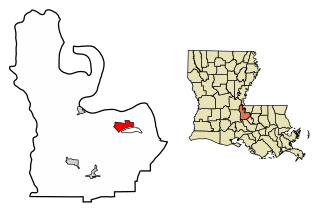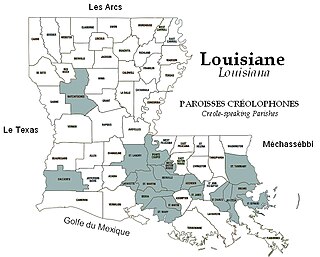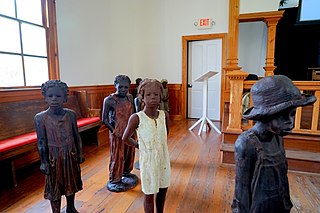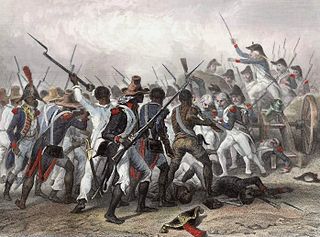Related Research Articles

Pointe Coupee Parish is a parish located in the U.S. state of Louisiana. As of the 2020 census, the population was 20,758. The parish seat is New Roads.

New Roads is a city in and the parish seat of Pointe Coupee Parish, Louisiana, United States. The center of population of Louisiana was located in New Roads in 2000. The population was 4,831 at the 2010 census, down from 4,966 in 2000. In the 2020 census the population was 4,549, while at the beginning year of 2023 the census showed a population of 4,205 and expects to be under 4,000 by the years end. The city's ZIP code is 70760. It is part of the Baton Rouge Metropolitan Statistical Area.

Acadiana, also known as the Cajun Country, is the official name given to the French Louisiana region that has historically contained much of the state's Francophone population.

The Gullah are a subgroup of the African American ethnic group, who predominantly live in the Lowcountry region of the U.S. states of South Carolina, North Carolina, Georgia, and Florida within the coastal plain and the Sea Islands. Their language and culture have preserved a significant influence of Africanisms as a result of their historical geographic isolation and the community's relation to their shared history and identity.

Louisiana Creole is a French-based creole language spoken by fewer than 10,000 people, mostly in the state of Louisiana. Also known as Kouri-Vini, it is spoken today by people who may racially identify as white, black, mixed, and Native American, as well as Cajun and Creole. It should not be confused with its sister language, Louisiana French, a dialect of the French language. Many Louisiana Creoles do not speak the Louisiana Creole language and may instead use French or English as their everyday languages.

Louisiana Creoles are a Louisiana French ethnic group descended from the inhabitants of colonial Louisiana before it became a part of the United States during the period of both French and Spanish rule. They share cultural ties such as the traditional use of the French, Spanish, and Creole languages and predominant practice of Catholicism.

Lakeland, is a village in southeastern Pointe Coupee Parish, Louisiana United States. The area is home to several plantation houses such as Alma and Poydras Plantations.
The history of the area that is now the U.S. state of Louisiana, can be traced back thousands of years to when it was occupied by indigenous peoples. The first indications of permanent settlement, ushering in the Archaic period, appear about 5,500 years ago. The area that is now Louisiana formed part of the Eastern Agricultural Complex. The Marksville culture emerged about 2,000 years ago out of the earlier Tchefuncte culture. It is considered ancestral to the Natchez and Taensa peoples. Around the year 800 CE, the Mississippian culture emerged from the Woodland period. The emergence of the Southeastern Ceremonial Complex coincides with the adoption of maize agriculture and chiefdom-level complex social organization beginning in circa 1200 CE. The Mississippian culture mostly disappeared around the 16th century, with the exception of some Natchez communities that maintained Mississippian cultural practices into the 1700s.

Atlantic Creole is a cultural identifier of those with origins in the transatlantic settlement of the Americas via Europe and Africa.

Jean Saint Malo in French, also known as Juan San Maló in Spanish, was the leader of a group of runaway enslaved Africans, known as Maroons, in Spanish Louisiana.
Point Coupee is the name of an unincorporated community located in Pointe Coupee Parish, Louisiana, United States. It is the home of St. Francis Chapel and is located along Louisiana Highway 420, north of New Roads, the parish seat.

Gwendolyn Midlo Hall was an American historian who focused on the history of slavery in the Caribbean, Latin America, Louisiana, Africa, and the African Diaspora in the Americas. Discovering extensive French and Spanish colonial documents related to the slave trade in Louisiana, she wrote Africans in Colonial Louisiana: The Development of Afro-Creole Culture in the Eighteenth Century (1992), studied the ethnic origins of enslaved Africans brought to Louisiana, as well as the process of creolization, which created new cultures. She changed the way in which several related disciplines are researched and taught, adding to scholarly understanding of the diverse origins of cultures throughout the Americas.
Jean Claude Trénonay de Chanfrey (1733–1792) was a wealthy slave-owner who owned a plantation near Point Coupee, Spanish Louisiana. In 1791, he owned 111 slaves.
Beninese American are Americans of Beninese descent. According to the census of 2000, in the United States there are only 605 Americans of Beninese origin. However, because since the first half of the eighteenth century to nineteenth many slaves were exported from Benin to the present United States, the number of African Americans with one or more Beninese ancestors could be much higher. The number of slaves from Bight of Benin exported to present United States exceeded 6,000 people, although this might consist not only in Benin, but also washes the shores of Ghana, Togo and Nigeria. It is also important to note that they were slaves from modern Benin, who exchanged voodoo practices with Francophone African descendants in Louisiana. Currently, there are Beninese communities in cities such as Chicago or Washington, D.C., Philadelphia and in other states as New York. As of 2021, there were over 500 Beninese immigrants in the town of Austin, Minnesota.
Yoruba Americans are Americans of Yoruba descent. The Yoruba people are a West African ethnic group that predominantly inhabits southwestern Nigeria, with smaller indigenous communities in Benin and Togo.

African Americans in Louisiana or Black Louisianians are residents of the U.S. state of Louisiana who are of African ancestry; those native to the state since colonial times descend from the many African slaves working on indigo and sugarcane plantations under French colonial rule.
Creole is an unincorporated community in Cameron Parish, Louisiana, United States. The ZIP Code for Creole is 70632.

Following Robert Cavelier de La Salle establishing the French claim to the territory and the introduction of the name Louisiana, the first settlements in the southernmost portion of Louisiana were developed at present-day Biloxi (1699), Mobile (1702), Natchitoches (1714), and New Orleans (1718). Slavery was then established by European colonists.

On June 25, 1791, a group of enslaved Mina gathered on the estate of the widow Robillard in New Roads, Pointe Coupée Parish. Jean-Louis, who was enslaved there, organized regular balls for Mina men. During the gathering, a plan was made for the Mina to rise up and free themselves, gathering pickaxes, knives, and other weapons to mount an attack on a storekeeper who could be raided for guns, gunpowder, shot, and other weapons. The only two non-Mina people involved were Cæsar, from Jamaica, and Pedro Chamba, who was ethnically Chamba but had been raised by the Mina.

The Pointe Coupée Slave Conspiracy of 1795 was an attempted slave rebellion which took place in Spanish Louisiana in 1795. It has attracted a lot of attention and been the subject of much historical research. It was preceded by the Pointe Coupée Slave Conspiracy of 1791.
References
- 1 2 3 Hall, Gwendolyn Midlo (1992). Africans in Colonial Louisiana. Louisiana State University Press. pp. 319–321. ISBN 9780807119990 . Retrieved August 3, 2012.
- ↑ Speedy, Karin (1995), "Mississippi and Tèche Creole: two separate starting points for Creole in Louisiana", in Baker, Phillip (ed.), From Contact to Creole and Beyond, London: University of Westminster Press, p. 106, ISBN 9781859190869
- ↑ Hall, Gwendolyn Midlo (2005). Slavery and African Ethnicities in the Americas: Restoring the Links. Chapel Hill, North Carolina: University of North Carolina Press. ISBN 978-0-8078-2973-8. OCLC 646875495.